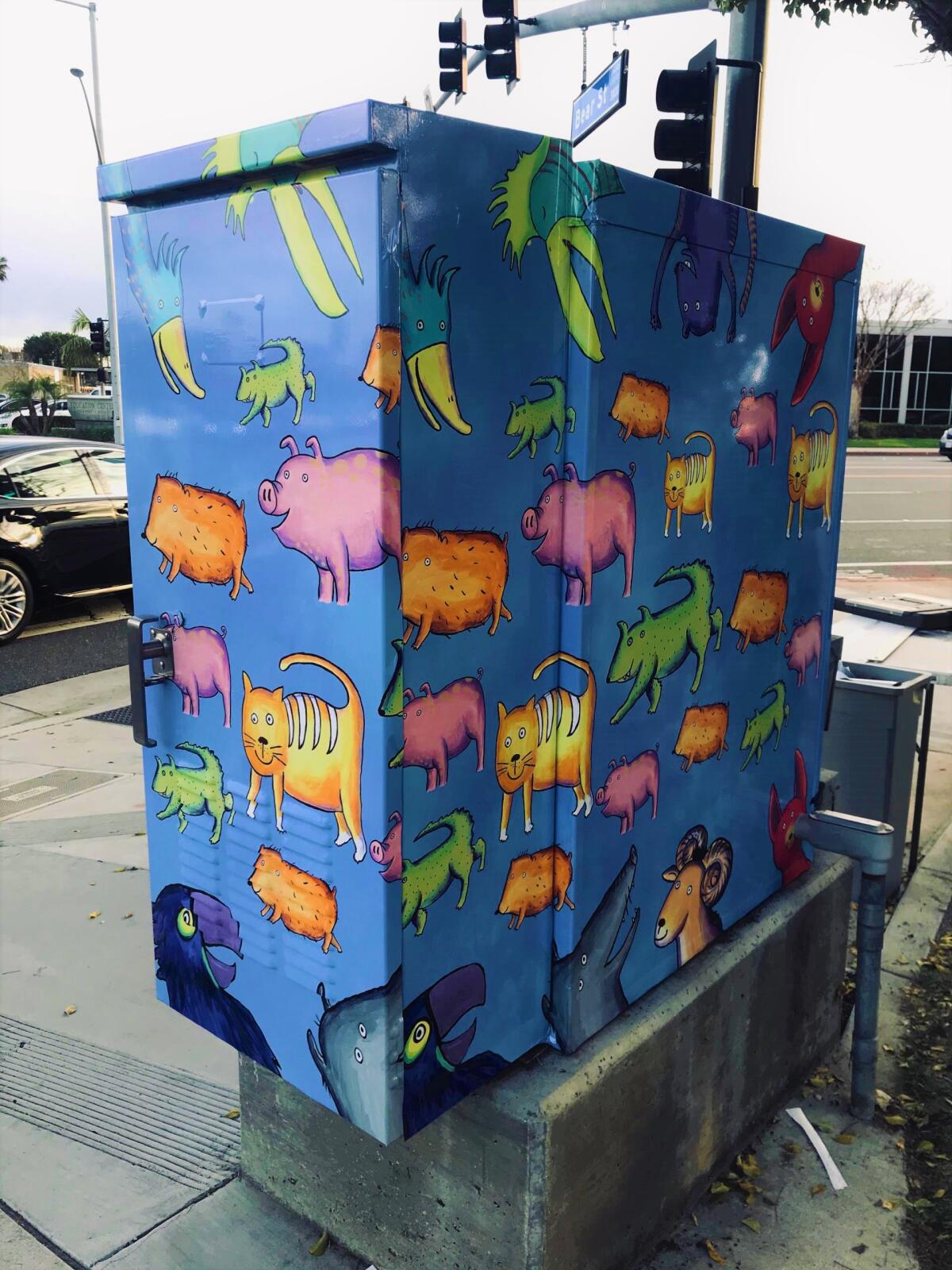Costa Mesa earmarked a slice of cannabis tax revenue for the arts. Where is it going?
April 11, 2025
When Costa Mesa officials drafted the city’s retail cannabis ordinance, they agreed to dedicate one-half cent of the 7-cent-per-dollar tax toward the implementation of an Arts & Culture Master Plan. But until recently, it’s been unclear where the money’s going.
Adopted in 2021, the same year as the cannabis law was crafted following the passage of Measure Q, the arts master plan took years to create as public input was sought on how citywide art and cultural events, programs, policies and staffing might be developed over a five-year period.
The document comprised existing events — like a utility box art program and the annual ARTventure — and also called for new commitments, such as establishment of the seven-member Arts Commission and creation of a full-time arts specialist, hired in 2022 at an annual salary of $120,000.

A utility box art wrap program is included in Costa Mesa’s Arts & Culture Master Plan.
(City of Costa Mesa)
Some saw the tax earmark as a shot in the arm for local arts, including Costa Mesa Mayor John Stephens, who helped draft the recommendation as part of a council-appointed cannabis ad hoc committee.
“Everybody, I think, realized it was a good thing to put money behind — here’s a fund to hopefully spur and inspire some investment into public art,” Stephens said Thursday. “My view was we’d see some great public art.”
Now, with more than $3.3 million in total revenue having so far been generated from the legal sale of marijuana, the application of the arts funding is not so visible.
Parks & Community Services Director Brian Gruner explained during an April 3 Arts Commission meeting the cannabis tax funds were not being accumulated for a special purpose, but were going into the city’s general fund, from which arts programs and initiatives have historically been covered.
Gruner told commissioners while city leaders initially projected the cannabis tax revenue would be sufficient to fund the total implementation of the master plan’s programs — around $8 million annually — actual income has been less robust, possibly due to a cap placed last year on the number of dispensaries allowed to do business.
“Currenlty, the tax revenue coming in is not sufficient to basically fund the arts master plan, so the council has been supplementing additional funds from the general fund to help offset that,” he said. “The council has been very, very supportive of the arts, and they certainly make that a priority to continue the funding, at least for the next fiscal year.”
Total implementation of the five-year plan — which began July 2021 and ends in June 2026 — is estimated to cost $1,941,700, including a projected cost for next fiscal year of $457,300, according to figures provided by Gruner at last week’s commission meeting.
But given the arts master plan funding constitutes 1/14 of the total cannabis tax taken in, the city would have to earn $27,183,800 in revenue from dispensaries for arts and culture programs to be fully funded.
By contrast, figures provided in the 2024-25 adopted budget show only $420,967 in arts-related cannabis taxes will have been collected by June 30.
That the earmark is being returned to the city’s general fund came as a surprise to resident Jim Fitzpatrick, a former planning commissioner-turned-cannabis-consultant who makes frequent appearances at public meetings to decry what he sees as waste and misspending at City Hall.
“Measure Q came after the Arts & Culture Master Plan. [The arts tax] was never intended to fund it,” Fitzpatrick said during the Arts Commission meeting. “It was always intended to be incremental, over and above, to do more for the City of the Arts. Now [staff] is saying they’re having to supplement it with the general fund. They’ve got it backwards.”
City Finance Director Carol Molina, in the throes of preparing next fiscal year’s budget, deferred questions about the cannabis tax to Costa Mesa spokesman Tony Dodero, who clarified that the city’s intention was that the revenue would be the sole funding source for programs identified in the document.
“Ultimately, the money from Measure Q is supposed to totally fund the master plan, but at this point it’s not. And, because of that, for the last three years the city’s been taking money out of the general fund to fund the master plan,” Dodero said Wednesday.
Stephens said while that’s not exactly what he envisioned when the council approved the tax set-aside, he doesn’t think of using the general fund to pay for arts programming as a “subsidy.”
“My vision was that it would be tangible, that people would be able to see a tangible art piece and trace it back to the cannabis art funds,” the mayor said Thursday. “But it’s still obviously an additional source of funds we didn’t have before. If that allows us to get [an arts specialist], that wasn’t what I was thinking — but I don’t disagree with that.”
Search
RECENT PRESS RELEASES
Related Post




